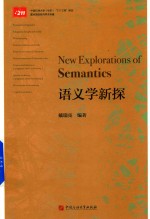图书介绍
语义学新探PDF|Epub|txt|kindle电子书版本网盘下载

- 戴瑞亮编著 著
- 出版社: 东营:石油大学出版社
- ISBN:9787563653645
- 出版时间:2016
- 标注页数:318页
- 文件大小:39MB
- 文件页数:334页
- 主题词:语义学-研究
PDF下载
下载说明
语义学新探PDF格式电子书版下载
下载的文件为RAR压缩包。需要使用解压软件进行解压得到PDF格式图书。建议使用BT下载工具Free Download Manager进行下载,简称FDM(免费,没有广告,支持多平台)。本站资源全部打包为BT种子。所以需要使用专业的BT下载软件进行下载。如BitComet qBittorrent uTorrent等BT下载工具。迅雷目前由于本站不是热门资源。不推荐使用!后期资源热门了。安装了迅雷也可以迅雷进行下载!
(文件页数 要大于 标注页数,上中下等多册电子书除外)
注意:本站所有压缩包均有解压码: 点击下载压缩包解压工具
图书目录
Chapter 1 Semantics in linguistics1
1.1 Definition of semantics1
1.2 Semantics and semiotics1
1.3 Semantics and pragmatics2
1.4 Some important assumptions2
1.4.1 Reference and sense3
1.4.2 Utterances,sentences and propositions4
1.4.3 Sentence meaning and utterance meaning6
1.4.4 Literal and non-literal meaning7
1.4.5 Refer and denote9
1.4.6 Referents and extensions9
1.4.7 Conceptual meaning and associative meaning9
1.5 Meanings of meaning10
1.5.1 The referential theory:meaning as naming10
1.5.2 Conceptualism:meaning as concept11
1.5.3 Contextualism:meaning as context13
1.5.4 Behaviorism:meaning as behavior14
1.6 Summary15
Chapter 2 Language,thought and reality16
2.1 Language and thought16
2.1.1 Language determines thought16
2.1.2 Thought determines language25
2.1.3 The language Of thought hypothesis26
2.2 Thought and reality27
2.3 Language and reality28
2.4 Summary29
Chapter 3 Word meaning31
3.1 What is a word?31
3.2 Lexical ambiguity and vagueness33
3.3 Sense relations36
3.3.1 Synonymy36
3.3.2 Antonymy37
3.3.3 Hyponymy39
3.3.4 Homonymy40
3.3.5 Polysemy41
3.3.6 Meronymy42
3.3.7 Member—collectiOn43
3.3.8 Portion—mass43
3.4 Summary44
Chapter 4 Sentence relations and truth45
4.1 Logic and truth45
4.2 Necessary truth,a priori truth and analyticity50
4.3 Entailment53
4.4 Presupposition56
4.4.1 Two approaches to presupposition57
4.4.2 Presupposition failure59
4.4.3 Presupposition triggers60
4.4.4 Presuppositions and context63
4.5 Summary65
Chapter 5 Sentence semantics 1:situations66
5.1 Situation types66
5.2 Verbs and situation types67
5.2.1 Stative verbs68
5.2.2 Dynamic verbs69
5.3 A system Of situation types72
5.4 Modality and evidentiality73
5.4.1 Modality73
5.4.2 Interpretations of some modal verbs78
5.4.3 Evidentiality81
5.5 Summary82
Chapter 6 Sentence semantics 2:thematic roles83
6.1 Thematic roles84
6.2 Identification of thematic roles86
6.3 Grammatical relations and thematic roles87
6.4 Problems with thematic roles89
6.5 The motivation for identifying thematic roles92
6.6 Voice93
6.7 Summary94
Chapter 7 Context and inference:a pragmatic study of meaning 196
7.1 Deixis96
7.1.1 Place deixis97
7.1.2 Person deixis99
7.1.3 Time deixis100
7.1.4 Discourse deixis101
7.1.5 Social deixis102
7.1.6 Grammaticalization of contextual information102
7.1.7 Metaphorical relationship between space,time and discourse deixis103
7.2 Reference and context104
7.3 Knowledge as context106
7.3.1 Situation as context106
7.3.2 Discourse as context107
7.3.3 Background knowledge as context110
7.3.4 Giving background knowledge to computers111
7.4 Information structure113
7.5 Inference117
7.6 Conversational implicature125
7.6.1 Grice's Cooperative Principle125
7.6.2 Post-Gricean developments133
7.7 Summary143
Chapter 8 Speech act theory:a pragmatic study Of meaning 2145
8.1 Austin's Speech Act Theory148
8.1.1 The performative-constative dichotomy148
8.1.2 Felicity conditions150
8.1.3 Collapse of the dichotomy152
8.1.4 Atheory of illocutionary act153
8.2 Searle's theory of speech acts154
8.3 Indirect speech acts158
8.4 Indirect speech acts and politeness161
8.5 Summary163
Chapter 9 Decomposition of meaning164
9.1 Componential analysis164
9.2 Katz's semantic theory169
9.2.1 The Katzian dictionary170
9.2.2 Projection rules171
9.3 Components and conflation patterns174
9.4 Conflation patterns Of motion verbs in English and Chinese177
9.4.1 Conflation patterns of manner verbs in English and Chinese177
9.4.2 Conflation patterns of path verbs in English and Chinese183
9.5 Predication analysis188
9.6 Summary189
Chapter 10 Cognitive semantics190
10.1 Metaphor and metonymy193
10.1.1 Metaphor193
10.1.2 Metonymy205
10.1.3 Metaphor-metonymy interaction212
10.2 Image schema214
10.2.1 Containment schema216
10.2.2 Path schema219
10.2.3 Force schema220
10.3 Polysemy223
10.3.1 Prepositions223
10.3.2 Modal verbs227
10.4 Categorization and idealized cognitive models230
10.4.1 Categorization230
10.4.2 Idealized cognitive models238
10.5 Iconicity250
10.5.1 Iconicity of order251
10.5.2 Iconicity of distance259
10.5.3 Iconicity of quantity265
10.5.4 Philosophical interpretation of iconicity270
10.5.5 Iconicity and Other competing principles272
10.6 Mental spaces276
10.6.1 Connections between spaces280
10.6.2 Referential opacity283
10.6.3 Presupposition287
10.7 Conceptual blending288
10.7.1 The Origins of Blending Theory290
10.7.2 Towards a theory of conceptual integration291
10.7.3 The nature of blending297
10.7.4 Contrasting Blending Theory with Conceptual Metaphor Theory304
10.8 Grammaticalization306
10.9 Summary309
Bibliography311